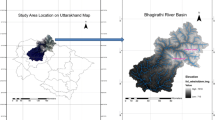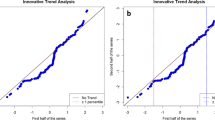Abstract
Mountainous regions are conspicuous due to their inimitable natural features. Natural regions are becoming progressively pretentious owing to the temperature variability pattern. Assessing temperature variability is vital to comprehend the physiography of these regions. Upper Teesta basin portrays a unique blend of a sub-tropical climate in the south and tundra type in the north. The Teesta river is considered as the lifeline of Sikkim, lies in the tundra type of climate covering the northern portion, where at least three months (November–January) of a year remain under deep snow and temperature hovering around 0 °C. The upper Teesta river basin covers the whole part of Sikkim scheming the lifestyle and occupation of the people based on the availability of its waters. Atmospheric temperature plays a crucial role in determining stream properties and water volume. Mean monthly temperature data acquired from India Meteorological Department as well as The National Centre for Environmental Prediction (NCEP) have been analysed with the help of kurtosis, skewness, and visualization done through Z-distribution in GIS environment. It provides a strategic outlook towards the proper utilization of the river water despite maintaining harmony with the climate of the region. The result depicts changes in the river itinerary concerning climatic variability pattern that calls for sustainable management of this water resource.







Similar content being viewed by others
References
Beniston M (1997) Variations of snow depth and duration in the Swiss Alps over the last 50 Years: links to changes in large-scale climatic forcing. Clim Change 36:281–300
Beniston M (2003) Climatic change in mountainous regions: a review of possible impacts. Clim Change 59:5–31
Beniston M (2005) The risks associated with climatic change in mountain regions. Global change and mountain regions. Springer, Dordrecht, pp 511–519
Bergstrom JC, Randall A (2016) Resource economics: an economic approach to natural resource and environmental policy. Edward Elgar Publishing, Cheltenham
Bhutiyani MR, Kale VS, Pawar NJ (2007) Long-term trends in maximum, minimum and mean annual air temperatures across the northwestern Himalaya during the 20th century. Clim Change 85:159–177
Bhutiyani MR, Kale VS, Pawar NJ (2009) Climate change and the precipitation variations in the northwestern Himalaya: 1866–2006. Int J Climatol J Royal Meteorol Soc 30(4):535–548
Borgaonkar HP, Pant GB (2001) Long-term climate variability over monsoon Asia as revealed by some proxy sources. Mausam 52:9–22
Brown LE, Hannah DM, Milner AM (2006) Hydroclimatological influences upon water column and streambed thermal dynamics in an alpine river system. J Hydrol 325:1–20
Bulmer MG (1979) Principles of statistics. Dover Publications
Cogălniceanu D, Vâlcu CM, Vâlcu M, Găldean N, Staicu G (2004) Seasonal variability of temperature in alpine lakes from the Retezat National Park, Romania, Studii şi Cercetări. Biologie 9:152–157 (Universitatea din Bacău)
Diaz HF, Bradley RS (1997) Temperature variations during the last century at high elevation sites. Clim Change 36:253–279
Diaz HF, Grosjean M, Graumlich L (2003) Climate variability and change in high elevation regions: past, present and future. Clim Change 59:1–4
Díaz J, García R, López C, Linares C, Tobías A, Prieto L (2005) Mortality impact of extreme winter temperatures. Int J Biometeorol 49(3):179–183
Evans EC, Petts GE (1997) Hyporheic temperature patterns within riffles. Hydrol Sci J (Journal Des Sciences Hydrologiques) 42:199–213
Fuhrer J, Beniston M, Fischlin A, Frei C, Goyette S, Jasper K, Pfister C (2006) Climate risks and their impact on agriculture and forests in Switzerland. In: Climate variability, predictability and climate risks. Springer, Dordrecht, pp 79–102
Goodbred SL Jr (2003) Response of the Ganges dispersal system to climate change: a source-to-sink view since the last interstade. Sed Geol 162(1–2):83–104
Goudie AS (2006) Global warming and fluvial geomorphology. Geomorphology 79(3–4):384–394
Hannah DM, Malcolm IA, Soulsby C, Youngson AF (2004) Heat exchanges and temperatures within a salmon spawning stream in the Cairngorms, Scotland: seasonal and sub-seasonal dynamics. River Res Appl 20:635–652
Hasanean HM (2001) Fluctuations of surface air temperature in the east Mediterranean. Theoret Appl Climatol 68(1–2):75–87
Hussain SS, Mudasser M, Sheikh MM, Manzoor N (2005) Climate change and variability in mountain regions of Pakistan implications for water and agriculture. Pak J Meteorol 2(4):75–90
IPCC (2007) Climate change and world food security: a new assessment. Glob Environ Change 9:S51–S67
Kapsomenakis J, Kolokotsa D, Nikolaou T, Santamouris M, Zerefos S (2013) Forty years increase of the air ambient temperature in Greece: the impact on buildings. Energy Convers Manage 74:353–365
Balanda KP, Mac Gillivray HL (1988) Kurtosis: a critical review. Am Stat 42(2):111–119
Kohler T, Maselli D, Neu U (2011) Mountains and climate change: a global concern. Alpine J 115(359):231–239
Livingstone DM, Dokulil MT (2001) Eighty years of spatially coherent Austrian lake surface temperatures and their relationship to regional air temperature and the North Atlantic Oscillation. Limnol Oceanogr 46(5):1220–1227
Marengo JA (2004) Characteristics and spatio-temporal variability of the Amazon River basin water budget. Clim Dyn 24(1):11–22
Meissner KJ, Weaver AJ, Matthews HD, Cox PM (2003) The role of land surface dynamics in glacial inception: a study with the UVic Earth System Model. Clim Dyn 21(7–8):515–537
Menzel L, Bürger G (2002) Climate change scenarios and runoff response in the Mulde catchment (Southern Elbe, Germany). J Hydrol 267(1–2):53–64
Mishra PK, Rai SC (2014) A cost–benefit analysis of indigenous soil and water conservation measures in Sikkim Himalaya, India. Mt Res Dev 34(1):27–35
Mitchell JM (Jr), Dzerdzeevskii B, Flohn H, Hofmeyr WL, Lamb HH, Rao KN, Wallen CC (1966) WMO Technical Note No. 79, World Meteorological Organization, Geneva
Monecke K, Winsemann J, Hanisch J (2001) Climatic response of Quaternary alluvial deposits in the upper Kali Gandaki valley (West Nepal). Glob Planet Change 28(1–4):293–302
Piao S, Ciais P, Huang Y, Shen Z, Peng S, Li J, Zhou L, Liu H, Ma Y, Ding Y, Friedlingstein P (2010) The impacts of climate change on water resources and agriculture in China. Nature 467(7311):43–51
Snyder PK, Delire C, Foley JA (2004) Evaluating the influence of different vegetation biomes on the global climate. Climatol Dyn 23:279–302
Türkeş M, Sümer UM, Demi̇r İ (2002) Re-evaluation of trends and changes in mean, maximum and minimum temperatures of Turkey for the period 1929–1999. Int J Climatol 22(8):947–977
Van Beers W (2005) Kriging metamodeling in discrete-event simulation: an overview. In: Proceedings of the 37th conference on Winter simulation. Winter Simulation Conference, pp 202–208
Vandenberghe J, Kasse C, Bohncke S, Kozarski S (1994) Climate-related river activity at the Weichselian-Holocene transition: a comparative study of the Warta and Maas rivers. Terra Nova 6(5):476–485
Villaba R, Lara A, Boninsegna JA, Masiokas M, Delgado S, Aravena JC, Roig FA, Schmelter A, Wolodarsky A, Ripalta A (2003) Largescale temporal changes across the southern Andes: 20th century variations in the context of the past 400 years. Clim Change 59:177–232
Wibig J, Glowicki B (2002) Trends in minimum and maximum temperature in Poland. Clim Res 20:123–133
Wigley TM (1985) Climatology: impact of extreme events. Nature 316:106–107
World Meteorological Organization (2003) Statement on the status of global climate in 2003. WMO, Geneva, Switzerland. Publication No. 966
Zhang X, Sheng W, Qi S (2018) Hazards and reflection on Fangshan District extreme rainstorm of July 21, 2012, the urban mountainous region of Beijing, North China. Nat Hazards 94(3):1459–1461
Acknowledgements
We express our sincere thanks to University Grants Commission (UGC), Government of India for the financial support to carry out this work. The authors are also grateful to anonymous reviewers and editors for their constructive comments.
Author information
Authors and Affiliations
Corresponding author
Additional information
Publisher's Note
Springer Nature remains neutral with regard to jurisdictional claims in published maps and institutional affiliations.
Rights and permissions
About this article
Cite this article
Mishra, A.K., Rai, S.C. Assessment of spatio-temporal variability of temperature using geo-statistical techniques: a case study of Upper Teesta River Basin, India. Environmental Sustainability 2, 43–54 (2019). https://doi.org/10.1007/s42398-019-00049-1
Received:
Revised:
Accepted:
Published:
Issue Date:
DOI: https://doi.org/10.1007/s42398-019-00049-1




